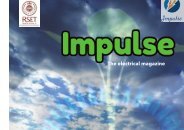impulse-ed 2-060417
You also want an ePaper? Increase the reach of your titles
YUMPU automatically turns print PDFs into web optimized ePapers that Google loves.
IMPULSE 2017<br />
DEE, RSET<br />
INTEGRATION OF SC METHODOLOGIES WITH<br />
Fundamentals of SMC<br />
SLIDING MODE CONTROL<br />
The SMC theory was originat<strong>ed</strong> in late 1950s in the former USSR, l<strong>ed</strong> by Prof. V. I. Utkin and<br />
Prof. S. V. Emelyanov [2] to address specific problems associat<strong>ed</strong> with a special class of VSSs,<br />
which are the control systems involving discontinuous control actions.<br />
In the early days of VSS, the research was focus<strong>ed</strong> on single-input and single-output systems, and<br />
various well-known methodologies were develop<strong>ed</strong>, e.g., the eigen value assignment approach [2],<br />
the Fillipov approach [5], etc. In recent years, the majority of research in SMC has been done with<br />
regard to multiinput and multioutput systems (MIMO), so we will use MIMO system framework<br />
as a platform for discussing the integration of SC methodologies in SMC. Commonly, the MIMO<br />
SMC systems consider<strong>ed</strong> are of the form<br />
ẋ˙ = f(x, t) + B(x, t)u + ξ(x, t)<br />
where<br />
x ∈ R n u is the system state vector and ξ(x, t) ∈ Rn represents all the factors that affect the<br />
performance of the control system, such as disturbances and uncertainties in the parameters of the<br />
system.<br />
.It is well known that when this condition (the matching condition) is satisfi<strong>ed</strong>, the celebrat<strong>ed</strong><br />
invariance property of SMC stands.<br />
The design proc<strong>ed</strong>ure of SMC includes two major steps encompassing two main phases of SMC:<br />
1) Reaching phase: where the system state is driven from any initial state to reach the switching<br />
manifolds (the anticipat<strong>ed</strong> sliding modes) in finite time;<br />
2) Sliding-mode phase: where the system is induc<strong>ed</strong> into the sliding motion on the switching<br />
manifolds, i.e., the switching manifolds become an attractor. These two phases correspond to the<br />
following two main design steps.<br />
1) Switching manifold selection: A set of switching manifolds are select<strong>ed</strong> with prescrib<strong>ed</strong><br />
desirable dynamical characteristics. Common candidates are linear hyper-planes.<br />
2) Discontinuous control design: A discontinuous control strategy is form<strong>ed</strong> to ensure the finite<br />
time reachability of the switching manifolds. The controller may be either local or global,<br />
depending upon specific control requirements.<br />
In the context of the system (1), following the main SMC design steps, the switching manifolds<br />
can be denot<strong>ed</strong> as<br />
s(x) = 0 ∈ Rm, where s = (s1, . . . , sm)T<br />
is characteriz<strong>ed</strong> by the control structure defin<strong>ed</strong> by




